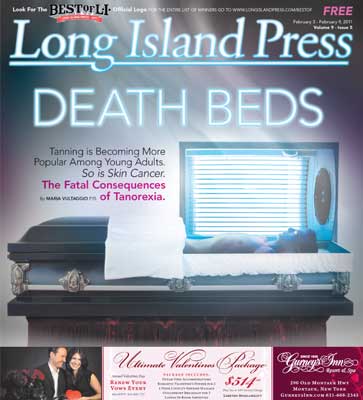

Walking into a popular Selden tanning salon, a person might be enamored of the beach decor and tropical scents of coconut.
There are no signs reminding you to “tan responsibly” the way most alcohol labels warn drinkers to “drink responsibly.” Likewise, there are no signs revealing how much damage a tanning session does to your skin in the way restaurants disclose the fattiness of their foods.
Instead, there is a man, overly tanned for January on Long Island, sitting at a desk with a welcoming smile. Instantly, his schmooze turns a one-time trial tan into a three-tan package deal: Buy two, get one free.
“Just wondering, do you ever let people tan more than once a day?” he is asked.
“No, I would never do that!” he answers. “But a little holy water never hurts anyone.”
He smiles and hands over a lotion called Sexy Tan.
“These are normally $2 each,” he says. “But I like you. Here.”
Talking later to a customer on the phone, he uses words like “refreshing” and “therapy session” when referring to tanning—ironic rhetoric for a hobby which can pose such severe risks.
He enters the tanning room and explains how to turn on the tanning bed by simply pressing a button, and leaves.
The room is empty now except for the tanning bed and the bottle of Sexy Tan lotion. It’s quiet. Hung on the walls are signs that read “Margaritaville” and “Paradise This Way.”
And, you know, tanning is relaxing. It is like being wrapped up in a warm cocoon. The tranquil hums and vibrations of the bed and fan can coerce those seeking some warmth in the winter into sleep. But that deep relaxation is over in 12 minutes.
“You look great,” the salon owner says. Not even a full minute after the tanning session is done, a compliment is received.
But bronzed bodies come at a cost.
It was once thought melanoma was an older person’s disease, but the deadly skin cancer has been increasingly diagnosed in young adults, especially women in their 20s. In 2009, the International Agency for Research on Cancer raised tanning beds to its highest cancer risk category: “carcinogenic to humans,” putting tanning beds in the same class as arsenic, asbestos, benzene, mustard gas, tobacco smoke and vinyl chloride.
And now studies show tanning can become addictive—and can have the same effect on the brain as heroin. Yet more and more people are turning to tanning beds, at a younger age, to get the sun they so desperately crave, despite the potentially deadly consequences.




